Skin flukes (Gyrodactylus) are common primary ectoparasites of fish, particularly in koi kept by hobbyists. Gyrodactylus cause severe skin and gill damage as they move and graze on the fish's mucus and epithelium. Fish respond to the irritation by flashing (scratching their flanks against objects and substrate). Untreated fluke infestations lead to skin ulceration, secondary bacterial infections and potential death. The parasites enter ponds and aquariums most commonly when infected fish are introduced, and can also be introduced by contaminated equipment, plants and water. These parasites accumulate and amplify in recirculating ponds, especially in ponds with high densities of fish. The first clinical signs of disease can be observed within 1 week in warm water temperatures (22–26°C) or within a month in cooler water temperatures (8–15°C).
Treatment, management and prognosis
Unlike gill flukes (Dactylogyrus), which are oviparous, skin flukes are viviparous trematodes. Eradication of skin flukes is often achievable using a single dose of treatment, as they lack a drug-re-sistant egg-stage. However, in practice, achieving eradication can be hindered by poor distribution of medicines around the aquatic system if plants or pond furnishings obstruct drug dispersal, rapid degradation of medications (ultraviolet steriliser, water chemistry, bacterial degradation, chemical filtration, photoinactivation, temperature) and drug resistance.
Factors that facilitate successful treatment outcomes include:
- Good water circulation for rapid and even distribution of medication, with no obstructions or substrate where pathogens can evade the medications
- Longer half-life of medicine
- Low organic matter and vegetation
- Optimal water quality conditions for the fish and medication.
There are a range of medications that are typically used to treat skin flukes, including trichlorfon, praziquantel, fluben-dazole, formalin and potassium permanganate. The choice of medication is based on water conditions as some medications are affected by the pH, water temperature, salinity and by the severity of illness. For example, trichlorfon can cause immuno-suppression and should not be used in fish with bacterial infections, and formalin should not be used at high water temperatures as it reduces dissolved oxygen.
In this case study, the pond had all the favourable features to effect eradication of Gyrodactylus, but after 3 years of unsuccessful treatments using the medicines above, it indicated the population of flukes were possibly multi-drug resistant. A different method of treatment was needed.
Case history and presentation
Thirty mature large koi ranging from 40 to 60 cm (4 to 7 kg) were housed in a L-shaped pond with vertical edges at a stocking density of 8 kg/kL. The pond holds 20 200 L of water and has ample water circulation with aerators and pumps. The water is filtered by a series of biofilters and polished with a pressure bead filter and ultraviolet steriliser (Figure 1). The koi came from a variety of sources, increasing the likelihood of different populations of parasites being introduced, any of which may have been exposed to various kinds of medications.
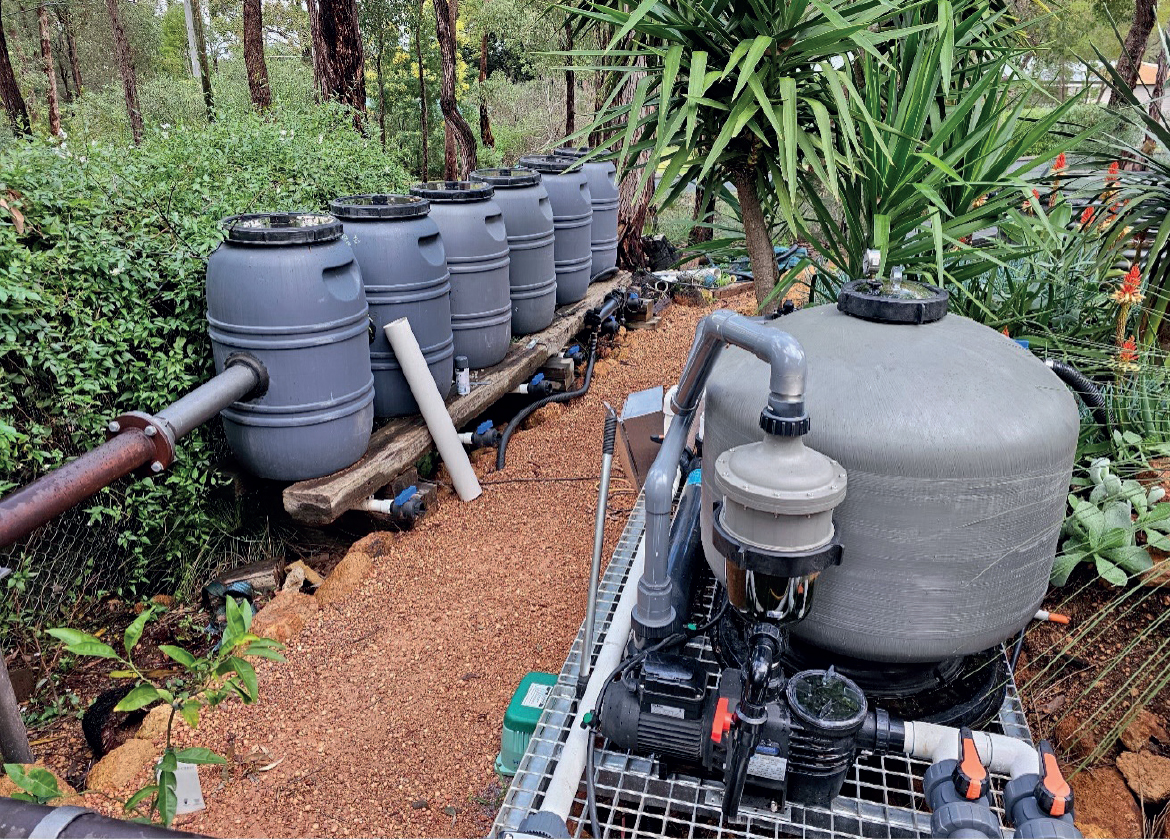
The pond holds 20 200 L of water and has ample water circulation with aerators and pumps. The water is filtered by a series of biofilters and polished with a pressure bead filter and ultraviolet lights (Figure 1).
The water parameters were:
- Total ammonia nitrogen: 0 mg/L
- Nitrite: 0 mg/L
- pH: 7.0
- Alkilinity: 40 mg/L
- Nitrate: 25 mg/L
- Water temperature: 21°C.
These parameters were tested using Sera® water test kits and Digitech pH Meter Pen. The pond's pH was stable as there was no vegetation or algae in the pond that could cause diurnal variations in pH.
Koi fish in the pond were observed to flash fairly regularly. Two individuals had focal dermal erythema on their flanks. Microscopic examinations of skin mucus scrapes and gill biopsies from the two fish revealed low numbers of Gyrodactylus.
Case management
The author has attended many cases where pH crashes occurred due to depletion of alkalinity over time. When the author's clients experience a pH crash, it can be several days – or longer – before veterinary services are sought. Frequently, these cases involve koi cohabiting with other species such as Tandanus catfish or silver perch (Bidyanus bidyanus), where those other species of fish that are less tolerant of acidity are found dead. The koi may show no clinical signs of illness in the earlier stages of exposure to acidic water, but in chronic cases, they may develop dermal hyperaemia, listlessness, appetite loss and clamped fins, with or without mortalities. Stable bubbles may accumulate at the edges of the pond as fish respond to the acidity by producing more mucus – the proteins in the mucins, when combined with water agitation, create the froth. On routine microscopic examinations of skin scrapes and gill biopsies, parasites and environmental microorganisms were absent whenever the pH of the water fell below 5.0.
Acetic acid is used as a dip or bath method to kill ectoparasites on fish, at a rate of 1–2 ml/L for 30–40 seconds, or 0.5–1.0 ml/L for 1–10 minutes respectively (Loh, 2021). However, this is the only case where the author has used acetic acid as a prolonged immersion.
The plan for treating this pond of fish with presumably multi-drug resistant flukes was to reduce and maintain the pH between 4.5 and 5.0 for a period of one week by daily monitoring and dosing with acetic acid (Woolworths® Double Strength White Vinegar, 8% acidity).
Because acidity can have a detrimental effect on biofilter bacteria, the fish were fasted during the period of treatment to reduce waste production. The ultraviolet lights were turned off for the duration of treatment to avoid photo-degradation of acetic acid.
Day 1
A dose rate of 0.3 ml/L was established based on adding acetic acid to a subsample of water from the pond and monitoring the pH until it declined to 5.0. However, when initially dosing the 20 200 L pond, instead of 6 L, only 5 L was required to reduce the pH from 7.0 to 5.0.
Day 2
The fish continued to show signs of skin irritation by flashing and the pH had risen to 6.5. Another 7.5 L of acetic acid was added to lower the pH to 4.9. The region received 10.2 mm of rainfall that day (Farm Online, 2023), which may have affected the water parameters.
Day 3
The pH had returned to 6.5 the following day and required 8.5 L of acetic acid to bring the pH down to 4.9. The region received 1.8 mm of rainfall that day (Farm Online, 2023).
Day 4
Fish were still flashing. Again, the pH had returned to 6.5 and this time, 12 L of acetic acid was needed to reduce the pH to 4.8.
Day 5
The pH of the water on this day was 5.2 and 4 L of acetic acid was added to decrease the pH to 4.8. Some flashing by fish was still occurring. The region received 19.8 mm of rainfall that day (Farm Online, 2023).
Day 6
The pH recorded on this day was 5.4 and 6 L of acetic acid was required to acidify the water to a pH of 4.9. Foam started accumulating at the water surface (Figure 2). This froth is due to the increased secretion of mucins by fish in response to exposure to acidified water, which when combined with heavy water agitation created by the aerators, creates stable froth that accumulates at the water surface.
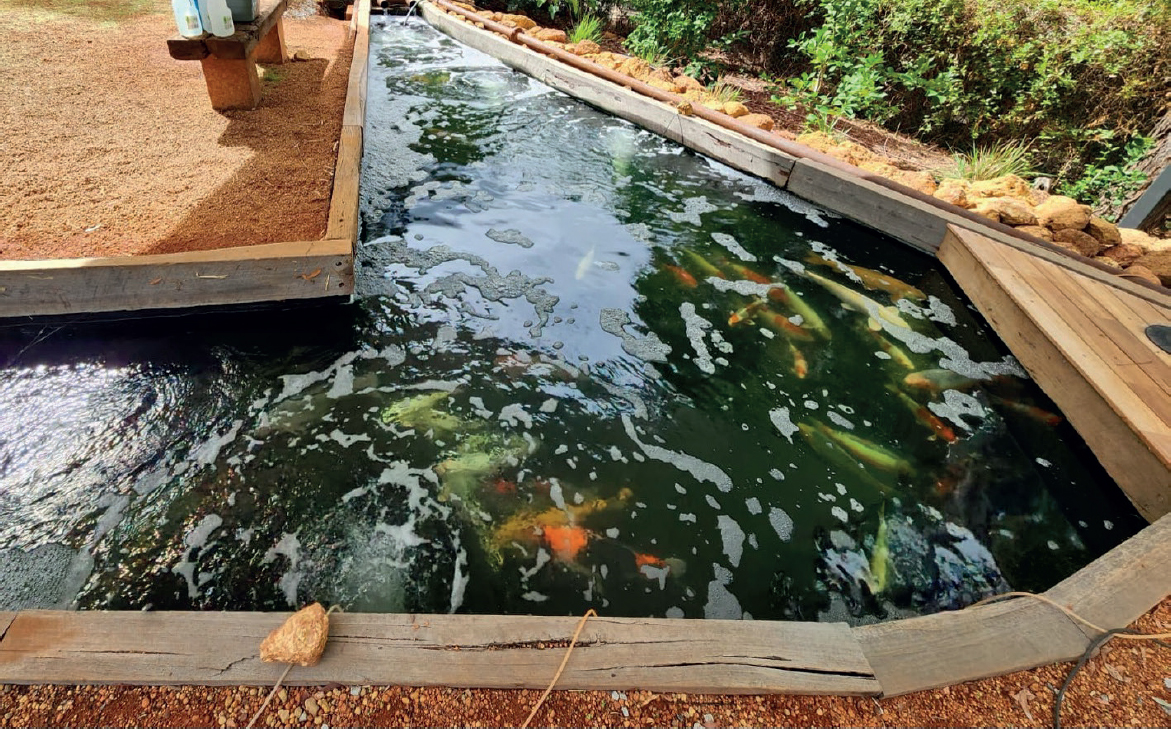
Day 7
The pH on this day was 5.3. All fish displayed normal healthy behaviour and there was no more evidence of flashing, however, one fish presented with reddening along its back (Figure 3), and another individual presented with melanisation with a similar anatomic distribution on its back (Figure 4).
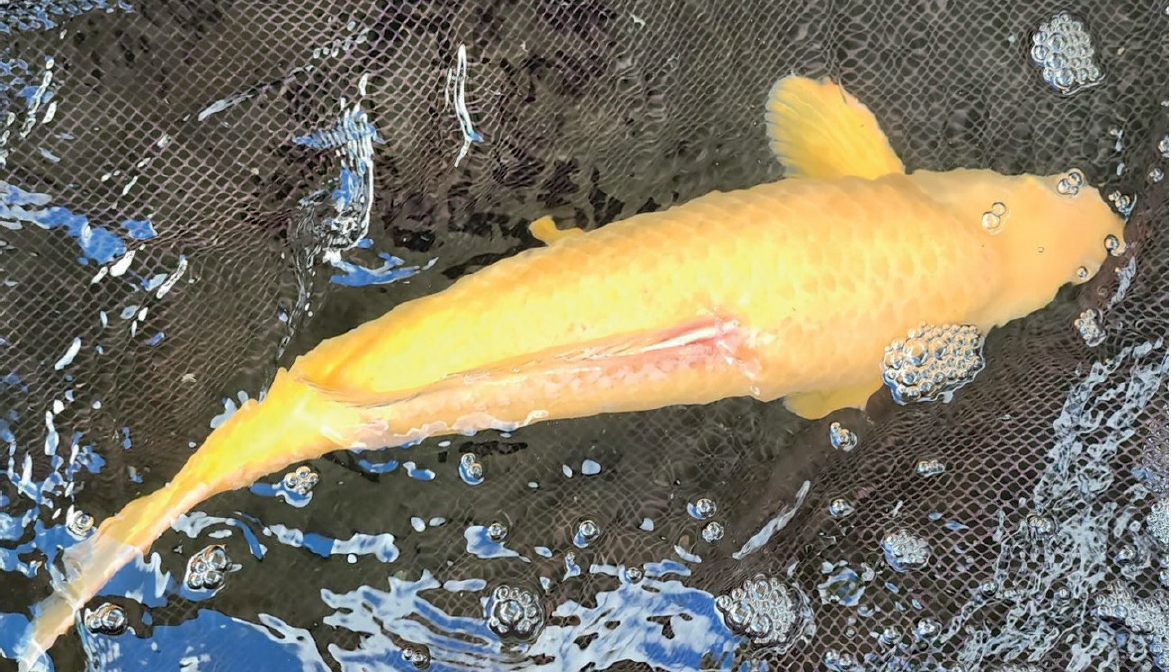
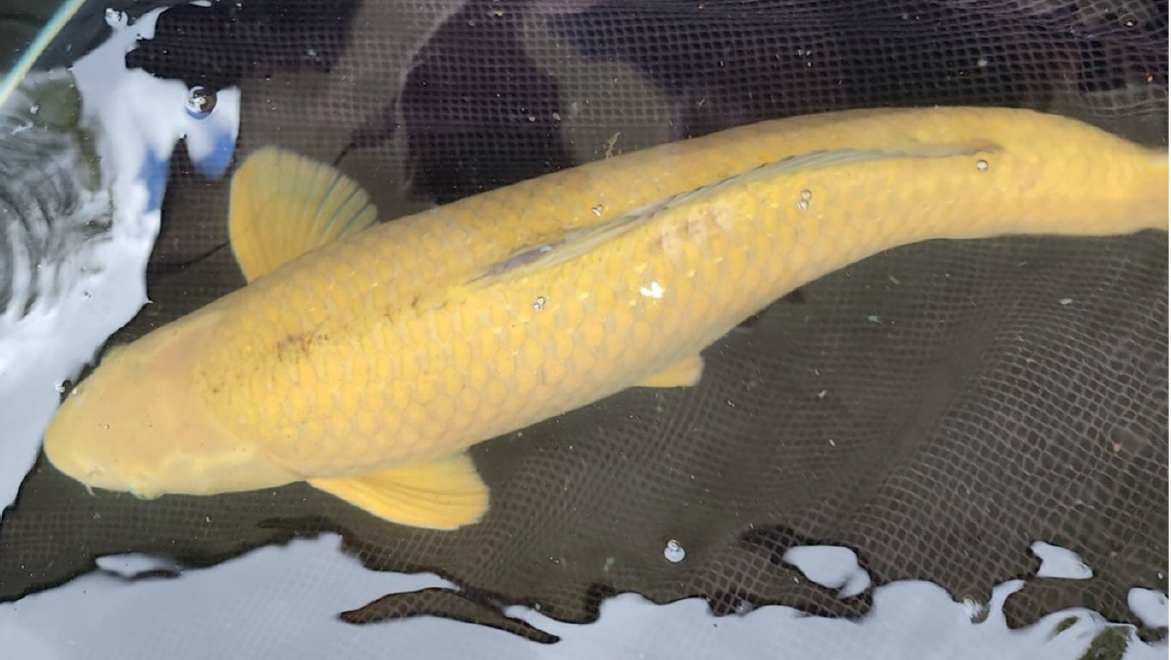
A partial water change of 4 kL was performed using scheme water with a typical alkalinity of 4 degrees. This marked the completion of the acetic acid treatment period. The author decided to stop the treatment given the flashing behaviour had ceased and to prevent worsening of the skin lesions.
The region received 4.0 mm of rainfall on day seven (Farm Online, 2023).
Day 8
The water turned a little cloudy and froth remained at the water surface, with larger bubbles forming (Figure 5). Another 4 kL partial water change was conducted.
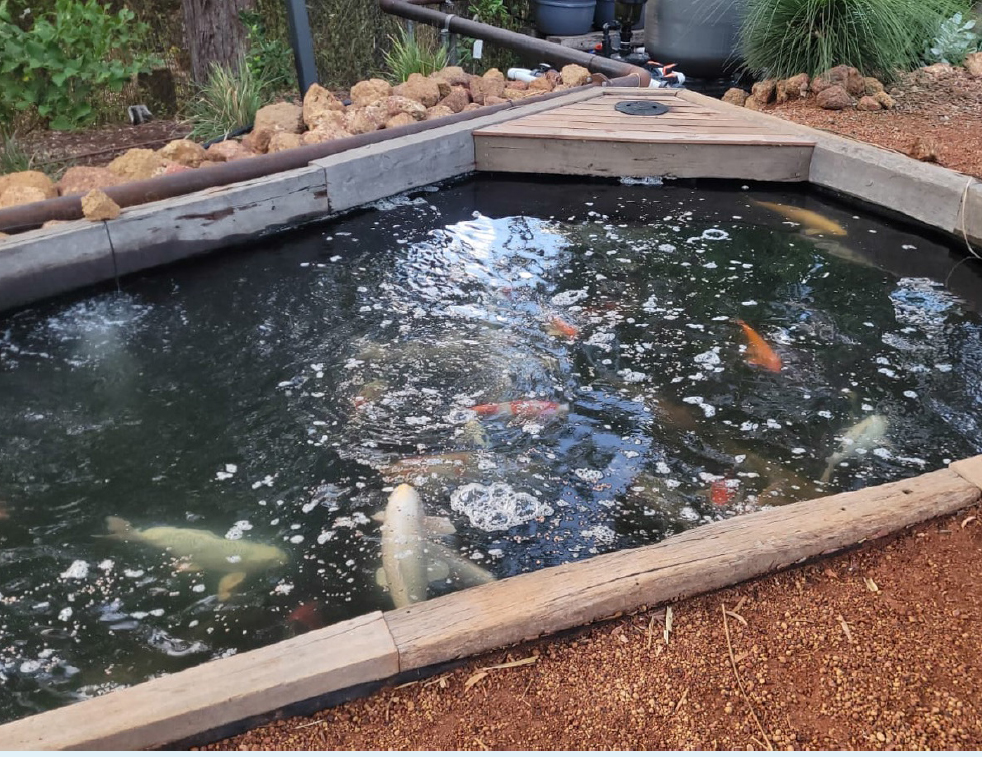
To prevent secondary bacterial and Saprolegnia infections, antibiotics and salt were administered. 20 kg of sodium chloride was added to the pond to promote slime coat production and to reduce osmoregulatory stress. Ten kilograms of food was medicated by surface-coating with 10 g of 48% trimethoprim sulpha powder per kilogram of food, bound with a light spray of canola oil (Woolworths® Canola Cooking Spray) and then lightly sprayed with Seachem GarlicGuard™ as an appetite stimulant. Fish were fed this as their sole ration, daily for 7 days.
The pH was raised gradually to 6.5 by the addition of a total of 200 g of sodium bicarbonate which was split across two doses, given 8 hours apart.
Day 9
The pH of the water was 7.2 and had a total ammonia nitrogen of 0.25 mg/L. There was a measurable amount of ammonia because the acidity of the water had a detrimental effect on the biofilter bacteria. The biofilter has a pH optimal range of between 7.2 and 8.8 and tolerates pH in a range of 5 and 9 (Loh and Bozic, 2023). This level of total ammonia nitrogen is not significant because at this pH and water temperature, the calculated concentration of free ammonia nitrogen of 0.002 mg/L remains below harmful levels (harmful levels of free ammonia nitrogen for adult fish are above 0.05 mg/L). The owner was instructed to continue monitoring the ammonia and nitrite daily over the next week to assess the trend.
Day 10
All fish behaved normally, and the water had returned to a normal clarity (Figure 6). There were no detectable levels of ammonia or nitrite and the pH remained stable at 7.2.
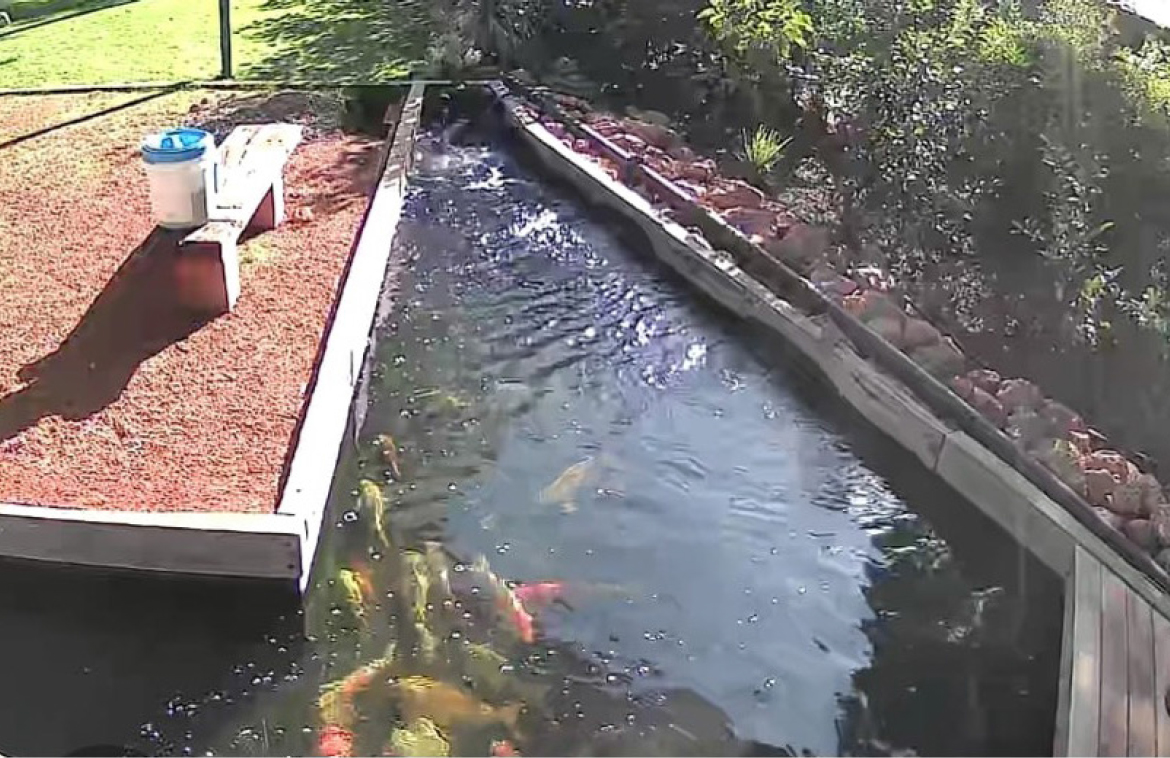
Day 12
As a precautionary step, 1.5 L of ADSI FinPROtect® was administered to the pond as it contains a proprietary ingredient derived from aloe vera plant that aids in the production of protective slime coat.
Day 111
From 16 April to 29 July, no signs of flashing have been observed (Figure 7). Normal, healthy behaviour and zero mortalities have been reported to date. Examination of skin mucus scrapes and gill biopsies from five fish revealed no evidence of ectoparasites. The water parameters were:
- Total ammonia nitrogen: 0 mg/L
- Nitrite: 0 mg/L
- pH: 6.5
- Alkilinity: 10 mg/L
- Nitrate: 10 mg/L
- Water temperature: 14 ºC
- Salinity: 0.5 g/L.
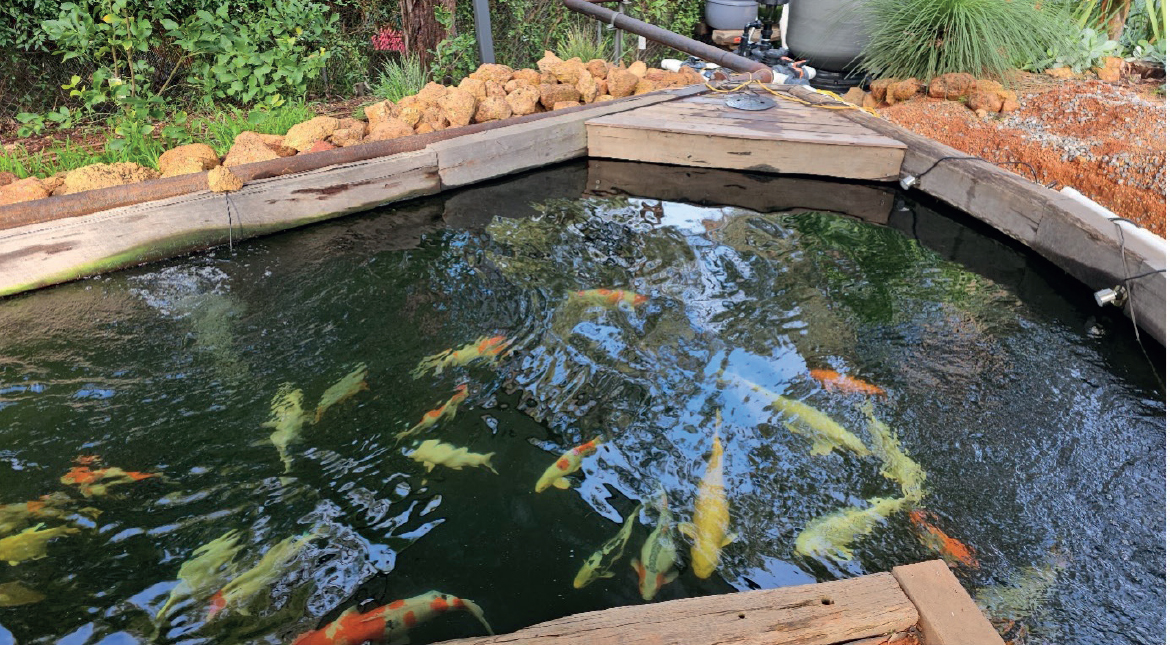
Because the alkalinity was low, 200 g of sodium bicarbonate was added.
Discussion
Acidity beyond a fish's tolerance range can cause significant stress on fish and initially cause increased mucus production, which is followed by damage to the epithelium leading to skin ulcers forming (Daye and Garside, 1976). Extreme acidity also reduces the oxygen-carrying capacity of fish (Ibrahim et al, 2020), because haemoglobin has a lower affnity for oxygen at a lower pH. As such, acid treatment should only be conducted with extreme care when all other avenues of safer medications have been exhausted. The acid treatment is not recommended to be conducted during warm water temperatures where dissolved oxygen is reduced, nor on fish intolerant of acidity.
The safety and welfare of fish were closely monitored throughout the treatment. Fish in the pond exhibited no signs of abnormal behaviour and continued to show a keen feeding response, swimming towards the owner expecting to be fed whenever he came close to the pond.
Following the acid-treatment, it is recommended to administer compounds that promote the return of a healthy slime coat. Initially, a gradual return of pH towards but below 7.0 is critical to avoid ammonia toxicity and allow the biofilter time to recover from the detrimental effects of the acidity. Once the ammonia and nitrite readings return to 0 mg/L, the pH can then be returned to a higher pH.
Acid treatment may be applicable to other kinds of ectoparasitic conditions. More research is required to determine the minimum treatment periods under different water conditions and with different fish species as acid-tolerance varies between fish species.
The author notes that the acid-treatment will not be practical in all situations, particularly in tanks or ponds with high alkalinity and pH, such as those constructed with concrete or limestone. Any shells, limestone or coral either in the pond or filter system must be removed several months before an acid-treatment in preparation, because of their pH buffering capacity.
Further studies are required to determine why increased amounts of acetic acid were needed to reduce the pH below 5. Complicating factors that may have affected the quantity of acetic acid required include the natural buffers in the water, dilution from rainfall, and microbial and chemical degradation (Kumbha et al, 2014). Additionally, the rising pH may in part be due to ammonia excreted by fish since ammonia has an alkaline pH.
Acid treatment may be applicable to other kinds of ectoparasitic conditions. More research is required to determine the minimum treatment periods under different water conditions and with different fish species as acid-tolerance varies between fish species.
The author notes that the acid-treatment will not be practical in all situations, particularly in tanks or ponds with high alkalinity and pH, such as those constructed with concrete or limestone. Any shells, limestone or coral either in the pond or filter system must be removed several months in preparation for an acid-treatment because of their pH buffering capacity.
Maximise your aquatic veterinary skills with the Fish Vet Masterclass. The ultimate online training course that teaches you all aspects of freshwater fish veterinary medicine, where you will learn how to expertly diagnose and treat fish diseases to a veterinary standard. Discover more at: http://fishvetmasterclass.mykajabi.com
KEY POINTS
- Skin flukes (Gyrodactylus) are a common ectoparasite in koi carp, especially in hobbyist ponds.
- Acidic dips are a method for treating fish against ectoparasites
- These fish were treated with a prolonged immersion in acidic water by using vinegar to acidify their home pond.
- After seven days, the fish all displayed normal healthy behaviour and there was no futher evidence of parasite burden.


